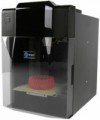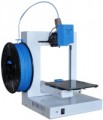Object dimensions (HxWxD)
The maximum dimensions of a product that can be printed on a 3D printer in one cycle.
The larger the dimensions of the model, the wider the choice for the user, the greater the variety of sizes available for printing. On the other hand, "large-sized" printers take a lot of space, and this parameter significantly affects the cost of the device. In addition, while printing a large model with FDM/FFF (see "Printing Technology"), larger nozzles and higher print speeds are desirable — and these features negatively affect detailing and the print quality of tiny objects. Therefore, while choosing, you should not aim the utmost maximum sizes — you should realistically assess the dimensions of the objects that you're going to print, and proceed from these data (plus a small margin in case of unexpected moments). In addition, we note that a large product can be printed in parts, and then piece these parts together.
Object volume
The largest volume of an object that can be printed on a printer. This indicator directly depends on the maximum dimensions (see above) — usually, it corresponds to these dimensions multiplied by each other. For example, dimensions of 230x240x270 mm will correspond to a volume of 23*24*27 = 14,904 cm³, that is, 14.9 litres.
The exact meaning of this indicator depends on the printing technology used (see above). These data are fundamental for photopolymer technologies SLA and DLP, as well as for powder SHS: the volume of the model corresponds to the amount of photopolymer/powder that needs to be loaded into the printer to print the product to the maximum height. If the size is smaller, this amount may decrease proportionally (for example, printing a model at half the maximum height will require half the volume), however, some printers require a full load regardless of the size of the product. In turn, for FDM/FFF and other similar technologies, the volume of the model is more of a reference value: the actual material consumption there will depend on the configuration of the printed product.
As for specific figures, the volume
up to 5 litres can be considered as small,
from 5 to 10 litres — medium,
more than 10 litres — large.
Min layer thickness
The smallest thickness of a single layer of material that can be applied with a printer.
In photopolymer devices of SLA and DLP formats (see "Print Technology") the meaning of this parameter is simple: it is the smallest height of a one pass cycle of the working platform. The smaller this height, the better detailing can be achieved on the device; however, in such models, this height is usually small — most often
less than 50 µm. But in devices based on FDM/FFF and similar technologies using nozzles, there are also higher rates —
51 – 100 µm and even
more. Here it is worth noting the fact that a small minimum layer thickness allows efficient use of small nozzles and achieves better detail. On the other hand, increasing detailing reduces productivity, and to compensate this fact, it is necessary to increase the print speed by increasing power (both heating and blowing), which, in turn, affects the cost. Therefore, choosing one should proceed from real needs: for objects with relatively low detail, there is no need to look for a printer with a small layer thickness.
It is worth noting that in FDM/FFF printers, the optimal layer thickness depends on the nozzle diameter (see below) and the specifics of printing — for example, for a “in one line” perimeter without filling, you can use the minimum layer thickness, while for filling it is not recommended. Det
...ailed recommendations on the optimal layer thickness for different situations can be found in special guides.Features
Additional features of the printer.
The list of the most popular features in modern 3D printers includes, in particular, a
heated bed,
a closed chamber,
object scanning,
a built-in camera, an
LCD display (including
touch),
filament sensor, as well as
resuming print function. Here is a more detailed description of these features:
— Heated bed. The availability of heating in the printing platform — the surface that is used as a support for the model to be built. This feature is found mainly in FDM/FFF printers (see "Printing Technology") and similar. The heated table ensures smooth and uniform cooling of the material, reducing the chance of deformations in completed models; this is especially important using materials with significant shrinkage. Also note that this feature is especially effective when combined with a closed print chamber (see below).
— Closed chamber. Operating area with a closed design. The specific designof such a chamber can be different — from a platform fenced on four sides to a sealed compartment where you can even create a vacuum for some specific printing methods. These nuances should be clarified separately. Anyway, the closed chamber protects the pr
...inted product from dust, moisture and other contaminants; but the more specific meaning of this feature may be different — depending on the printing technology (see above). So, in FFF/FDM printers and similar devices, the closed design allows to achieve more uniform cooling of the workpiece and avoids deformation due to material shrinkage. And almost all SLA and DLP units have such a design — even in the simplest models of this category, the operating area is covered at least with a light filter that protects the user from bright light.
— Object scanning. Built-in 3D scanner that allows you to create “digital masks” of various objects. The printer can recreate then a copy of the scanned item, based on that masks. This function actually turns the device into a three-dimensional copier: the user does not need to build a model in a CAD programme, it is enough to have a sample for copying. However, if necessary, the digital image can be edited — usually, the scanner allows you to transfer the received data to the same CAD programs.
— Built-in camera. Own digital camera installed directly into the printer and aimed at the operating area. Designed to capture the workflow; most often it allows you to shoot both photos and videos, but it's ok to clarify the specific shooting capabilities separately. Regarding the use of cameras, it is worth noting that printers with such equipment usually also have Wi-Fi modules and/or LAN network connectivity (see "Data Transfer"). This allows you to transfer the captured video over a local network or even over the Internet (these details, again, should be clarified for each model), and further use of the footage depends primarily on the user's desire. One of the most popular ways to use this is remote control of printing: if you have a camera, you can monitor the process without having to go to the printer once again. In addition, the data from the camera (live or recorded) can be used as a demonstration, as a visual aid for training/instruction, etc.
— Resume printing. A feature that allows you to continue the printing process after it has been stopped. It is useful primarily in cases where the printer is used at strictly defined hours — for example, during working hours; it can also come in handy if the printer is turned off due to a power failure. The second option is fairly obvious; and regarding the first, we should remind that 3D printing is a rather continuous process, and the creation of even a small product takes hours. Because of this, situations often arise when a work day (or other similar period of time) is not enough to complete the work. In such situations, the resume printing feature is useful: the printer can be paused for the duration of the absence, and to resume the process with returning to the printer. However, it should be noted that operating with some filaments, interruptions in work are undesirable; so if you plan to use this function, it's ok to clarify its compatibility with the preferred filament.
— Filament sensor. Sensor for controlling the supply of plastic filament during the printing process. As a rule, such a sensor is installed on the extruder (print head). If the filament suddenly runs out or its supply is interrupted, the sensor will prevent the print from failing due to lack of material - if it detects a lack of filament, it transmits a signal to stop the print so that the user can add filament and resume the process.
